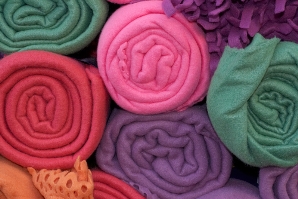Flannel facts and fables
 It’s getting to be that time again…time to put away the white pants. Time to check the weather stripping around the windows and doors. Time to put away the swimsuit and dig out the flannel pajamas!
It’s getting to be that time again…time to put away the white pants. Time to check the weather stripping around the windows and doors. Time to put away the swimsuit and dig out the flannel pajamas!
Who can resist the feel of that soft, cuddly fabric against your skin when the temperature starts to dip and the evening chill encourages you to throw the windows open at night?Flannel’s gotten a bad rep over the years as a sure sign that a woman has abandoned “sexy” for “snuggly”. But all it takes are icy feet on someone’s backside on a cold winter night to convince a man that flannel can actually “take the chill off” a marriage! Over the last decade even flannel sheets have become commonplace as a means to keep the warmth going.
Flannel quilts are the next logical step! Depending on your climate during the winter, flannel may be the farthest thing from your mind. But if you are anticipating a significant temperature drop in the next few months, consider starting a flannel project now so you can cozy up next to the fire in November. Here are some tips to working with flannel as a quilter:
- Pre-wash flannel whenever possible to remove shrinkage. Some loose-weave flannel can shrink as much as 10 percent, so plan accordingly when purchasing yardage for a specific project.
- Some flannel fabrics have a very definite “nap” which can create odd shadows on your quilt. Be sure to place the nap going in the same direction if you are using the flannel for backing fabric.
- To reduce bulk at piecing intersections, try shortening your stitch length and pressing seams open when possible. Choose a quilting design that crosses over the seams to add stability.
- As the texture or nap of the flannel gets thicker, the quilting thread will disappear more into the nap. If the color of the thread is important to your overall look, choose a thread that is 40 weight or thicker. This thread will lay on top of the nap rather than sinking in to the fibers. However, if you prefer that the quilting shows up only as “texture” then choose a finer weight thread.
- Stretchy, stretchy, stretchy. Flannel has lots of it! When loading flannel as a quilt backing, try to orient it so that the lengthwise grain is perpendicular to the rollers instead of parallel to them.
- Test any pantograph design you are considering to see if it intersects any bulky seams. While the hopping foot should do a decent job of jumping on top of bulky seams, if you meet one that is extreme then the foot will either push the seam around (distorting it) or it will try to penetrate it. If the needle can’t pierce the seam quickly enough and you move before the needle has exited the quilt, then a broken needle could be the result.
- Flannel leaves lots of lint behind. Clean the bobbin case and hook area out regularly while working on the project.
- Choose your batting wisely. Flannel will add warmth and weight to the quilt. For additional warmth but not much weight, add a polyester batting. For breathability and possible weight, choose cotton batting.
- Keep the quilting a bit farther apart on flannel quilts to maintain the fabric’s soft texture and drape. If you heavily quilt it, you’ll be sleeping under a board in your flannel nightie!



